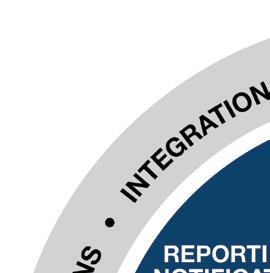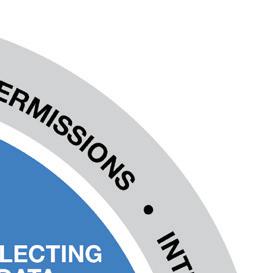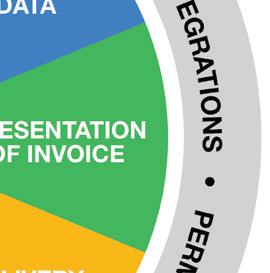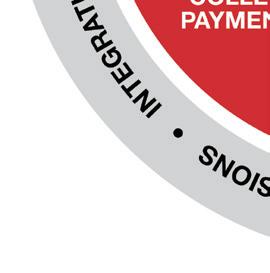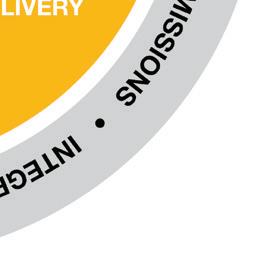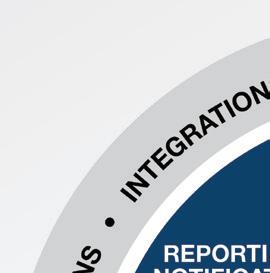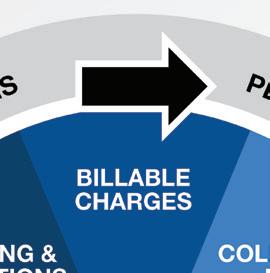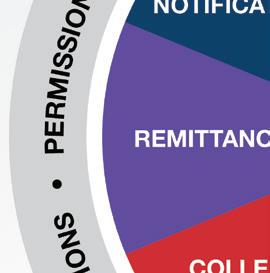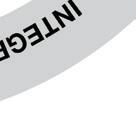






10 Inkjet Printing
Dealers enthusiastic about this adjacent opportunity
by Brent Hoskins Office Technology MagazineOne does not need to look beyond the home office to see inkjet printing technology in action. Might that reality ultimately drive greater demand and acceptance of inkjet in the workplace? This month’s cover story includes profiles of three dealerships focused on their inkjet offerings.


The Manager’s Dilemma
16
How much training should you invest in employees?
 by Dale Stein Technology Assurance Group (TAG)
by Dale Stein Technology Assurance Group (TAG)
After 40 years of launching, managing, scaling, selling and advising businesses, I have developed a sixth sense for knowing whether a business is destined for success or failure. In fact, it all comes down to a single factor. Educated employees can take your company to new heights, whereas uneducated employees can destroy it.
It is still important in today’s marketplace
by Robert Doucette Smart TechnologiesWhether we blame the COVID-19 pandemic, the current performance of the economy or the job market, customer service is becoming a dying art. Many businesses prioritize efficiency over the customer experience as technology evolves, leaving customers disconnected. Despite this trend, customer service is critical for business growth and success.
Q&A: Ron Petrucci
VP/GM shares a look at Katun & the dealer channel
Compiled by Brent Hoskins
Office Technology Magazine
Recently, Office Technology magazine interviewed Ron Petrucci, vice president and general manager of the Katun North America Business Unit (Katun). Founded 43 years ago, Katun is a leading provider of OEM-compatible imaging supplies, photoreceptors and parts for MFPs, printers and other imaging equipment.


34
Sharp Imaging and Information Company of America hosted its National Dealer Meeting April 18-21, 2023, in Las Vegas, Nevada. Themed “Opportunity Meets Execution,” nearly 1,000 attendees gathered to learn about the company’s new and upcoming products, solutions and programs.
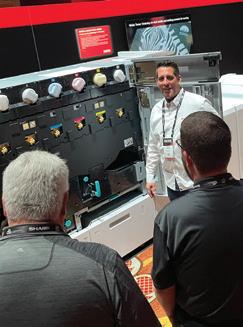
Things to consider to get an optimal result
by Robert C. Goldberg BTA General CounselSelling a business is a big deal and it should be approached in a strategic, coordinated fashion with the understanding that it will require a tremendous amount of effort. The good news is there is a proven path to success and experienced individuals who can help along the way.



Dealers share delivery, setup, install & connection fees
Compiled by Brent Hoskins
Office Technology Magazine
This article includes a question submitted by a dealer member as part of BTA’s Dealers Helping Dealers resource, and several of the answers received. These answers and many others can be found in the members-only section of the BTA website.

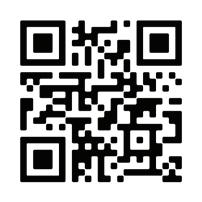

In the April issue of Office Technology, BTA President David Polimeni provided an overview of the upcoming Capture the Magic event, to be held June 9-10 in Denver, Colorado. Space was limited in that column, so this month I’d like to share more details about the event’s educational sessions.
During the keynote address, “Building Unstoppable Teams,” former Navy SEAL Curt Cronin will outline his five-step plan to building a proactive, unified team with complimentary skill sets. He will use anecdotes from his naval tours to draw parallels between his combat experience and the objectives of dealers.
Featured speaker Anthony Sci, president and CEO of Keypoint Intelligence, will present, “Preparing for the Future: Key Strategies for Success.” Sci will draw on his experience in the industry, research findings at Keypoint Intelligence and analysts’ projections for the future of the workplace to share how he would be preparing for a successful future if he owned an office technology dealership.
In “Demystifying AI: Practical Insights & Tools for Business Growth,” West McDonald of West McDonald Co. and Tigerpaw Software will help demystify the AI landscape and provide practical insights and tools for leveraging AI to drive business growth.

During “I Heard It Through the Grapevine,” BTA General Counsel Bob Goldberg will address employee issues, preparing a business for sale, non-compete agreements, supplier agreements and pricing, updated transactional documents, business culture, hybrid workers, ESG opportunities and more.
There will also be two dealer panel discussions. During the first panel, “Positioning Your Dealership for Greatness,” four
dealership representatives will share how they have diversified their product and services portfolios to ensure continued success now and into the future. During the second panel, “Meeting the Challenges Faced by Today’s Service Departments,” three service leaders will share what they are doing to ensure their service teams are at their best.
The event will also include breakout sessions: a dealer sales panel (offered twice with different panelists), two mailing equipment opportunity sessions and a service-focused session by CEO Juice (also offered twice).
The sales panel, “Optimizing Your Dealership’s Sales Team,” will feature six dealership principals/executives who will discuss how their companies are finding the right people, preparing them to succeed and motivating them to continually reach new heights.
The mailing equipment sessions will include a dealer panel and a session focused on postage meter decertification. During the panel, “Why Mailing is a Good Fit for BTA Dealers,” three dealers will explain why they got into selling mailing equipment and how it has had a positive impact on their sales and margin. The session, “Mailing Equipment Decertification & Its Opportunities,” will be split into two parts. The first part will be an update on the changes in mailing meter decertification, while the second part will focus on ideas and strategies that can be used to sell more products and services as you update mailing meters.
Finally, the service breakout session, “Key Metrics for Service Managers,” will walk attendees through CEO Juice’s service manager’s dashboard.
With all of these compelling educational sessions in mind, I encourage you to register for Capture the Magic. See the ad on pages two and three or visit www.bta.org/ BTADenver for more details or to register. n
— Brent HoskinsExecutive Director/BTA Editor/Office Technology
Brent Hoskins brent@bta.org
(816) 303-4040
Associate Editor
Elizabeth Marvel elizabeth@bta.org
(816) 303-4060
Contributing Writers Robert Doucette, Smart Technologies www.smarttechfl.com
Bob Goldberg, General Counsel Business Technology Association
Dale Stein, Technology Assurance Group www.tagnational.com
Business Technology Association


12411 Wornall Road
Kansas City, MO 64145
(816) 941-3100 www.bta.org
Member Services: (800) 505-2821
BTA Legal Hotline: (312) 648-2300

Valerie Briseno
Marketing Director valerie@bta.org
Brian Smith
Membership Sales Representative brian@bta.org
Photo Credits: Adobe Stock. Cover created by Bruce Quade, Brand X Studio. ©2023 by the Business Technology Association. All Rights Reserved. No part of this publication may be reproduced by any means without the written permission of the publisher. Every effort is made to ensure the accuracy of published material. However, the publisher assumes no liability for errors in articles nor are opinions expressed necessarily those of the publisher.
The association’s magazine cover 50 years ago this month — the NOMDA Spokesman, May 1973.


Are you a dealership owner or executive-level staff member? If so, I encourage you to attend the Business Technology Association’s (BTA’s) next ProFinance 3.0 workshop, to be held June 7-8 at BTA member dealership Metro Sales Inc. in Burnsville, Minnesota (a Minneapolis suburb). Since 2001, ProFinance has improved the performance of hundreds of dealerships. Will you and your company be among those receiving the information you need to gain the competitive edge that is so vital in today’s marketplace?

Now in its 23rd year, ProFinance is BTA’s longest-running educational workshop. During ProFinance, industry veterans John Hey and Todd Johnson of Strategic Business Associates share their knowledge from more than 25 years of building and advising some of the largest and most successful dealerships in the industry. They will give you the industry model (which is updated yearly and includes more than 30 key benchmarks), proven sales and service plans, effective management programs and critical organizational strategies.
The first day of ProFinance will begin at 8:30 a.m. with an overview of the financial model, its history, principles and application. After a break, John and Todd will introduce the MFP and MPS benchmark model and its components. There will be a break at noon for lunch.
After lunch, you will learn the details behind the benchmarks and how to apply them to your business. A problem-solving session will follow with sample problems and solutions. Wrapping up the first day, John and Todd will review the information covered and answer questions.
The second day will begin at 8:30 a.m. when John and Todd will review the information from day one, have a general discussion and share sales compensation strategies. After a break, they will teach attendees managed network services and imaging dealer strategies, and then share their thoughts on leadership and company culture. The workshop will conclude at noon with a review of all the information covered and a Q&A session.
The feedback BTA has received from ProFinance attendees over the years has been extremely positive. Following are some comments from recent attendees:
n “The exercises were fun for me, but I’m in finance. Everyone around me appreciated accounting for once! I loved getting the spreadsheets. [Learning how to] use the numbers to drive the business [was helpful]. It takes out the guesswork.” — Julie Toth, Plus Inc., Greenville, South Carolina
n “It [the information] was all very helpful. It was nice to see what components we are following, and what we can review and do better. It was also very helpful to have time to talk with others. I learned a lot from each section, and really enjoyed the compensation and culture sections.” — Destre Crawford, Standley Systems, Chickasha, Oklahoma
n “[It was helpful] to know that other dealers have the same issues we do in regard to comp plans, etc. [I learned] that we can fix any issues if we follow the model and don’t discount the aftermarket. Being a family business, I found it very insightful, as I am currently dealing with those dynamics.” — Matt Pokorney, Advanced Office Systems, Baton Rouge, Louisiana
BTA member tuition is $1,395. If you’ve attended previously and want the new benchmarks, you can attend again for 50% off. To register, visit www.bta.org/ProFinance. n
— David Polimeni2022-2023 Board of Directors
President
David Polimeni RITE Technology Sarasota, Florida dpolimeni@ritefl.com
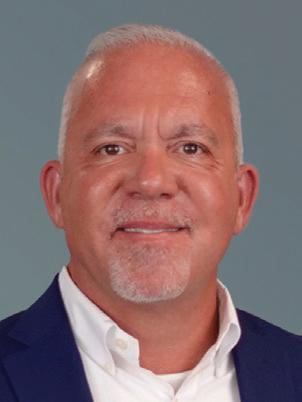
President-Elect
Don Risser DCS Technologies Corp. Franklin, Ohio don.risser@dcs-tech.com
Vice President
Adam Gregory Advanced Business Solutions LLC St. Augustine, Florida adam@goabsinc.com
Immediate Past President
Tim Renegar Kelly Office Solutions Winston-Salem, North Carolina trenegar@kellyofficesolutions.com
BTA East Mike Ardry Automated Business Solutions Warwick, Rhode Island mardry@absne.com
Mike Boyle BASE Technologies Inc. Bethel, Connecticut mboyle@baseinc.com
BTA Mid-America
Brantly Fowler Zeno Office Solutions Inc. Midland, Texas bfowler@zenotx.com
Greg Quirk JQ Office Equipment Omaha, Nebraska gquirk@jqoffice.com
BTA Southeast Debra Dennis CopyPro Inc. Greenville, North Carolina ddennis@copypro.net

Jim Buck Carolina Business Equipment Inc. Columbia, South Carolina jimb@cbesc.com
BTA West Dan Bombard Yuma Office Equipment, a Fruth Group Company Yuma, Arizona daniel@yumaofficeequipment.com
Mike McGuirk ProCopy Office Solutions Inc. Mesa, Arizona mmcguirk@procopyoffice.com
Ex-Officio/General Counsel
Robert C. Goldberg Schoenberg Finkel Beederman Bell & Glazer LLC Chicago, Illinois robert.goldberg@sfbbg.com
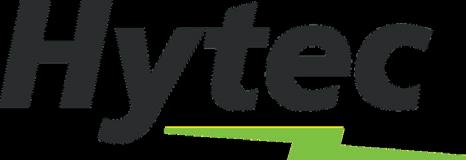

Hytec’s technical support can help you improve your firstcall effectiveness and reduce parts cost by providing troubleshooting advice

Hytec supports Canon, Fiery, HP, Konica Minolta, Kyocera, Ricoh, Sharp & Toshiba
Our fastest service alternative, providing you the ability to receive a circuit board the next business day

Our online inventory management saves you inventory costs while having Repairable Parts available next business day
Protect & Condition Power to ensure desired performance of equipment and reduce service calls.
HDD & Data Storage Part services for sanitization & destruction services based on your needs
One does not need to look beyond the home office to see inkjet printing technology in action (see the infographic on page 15 for confirmation). Might that reality ultimately drive greater demand and acceptance of inkjet in the workplace?
Below are profiles of three dealerships focused on their inkjet offerings. The first dealership sells inkjet exclusively, the second nearly exclusively. The third predominately sells laser devices but sees the promise of inkjet — now and in the future.
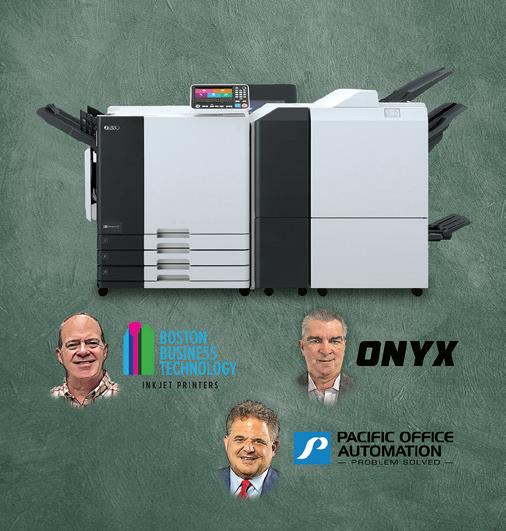
Todd Deluca’s career includes a long tenure with a manufacturer solely focused on inkjet technology. From 1998 to 2011 he worked in various management positions for RISO Inc. During his final six years of service, he was president and COO of the company, a wholly owned subsidiary of RISO Kagaku Corp., a manufacturer of high-speed inkjet printers and digital duplicators.
Today, Deluca is owner, president and CEO of Boston Business Technology, based in Plymouth, Massachusetts, and remains solely focused on inkjet. He established the dealership in 2020, having acquired a Boston-area customer base from RISO. Soon thereafter he added the Epson America Inc. line of inkjet printers and “all-in-one” products. “We wanted to expand the line, because I felt that RISO was moving upstream to transactional print houses, print for profit, etc., and I wanted inkjet products for the general office that could also replace duplicators in schools [nevertheless, the dealership continues to sell between 100 to 150 RISO duplicators annually],” Deluca says. “So, I partnered with Epson.”
There is a strategic reason for the sole focus on inkjet. “We only sell inkjet because we feel like we need to differentiate ourselves,” Deluca says. “There are a lot of great dealers out there selling a lot of great [laser] products, but they’re all very similar, so we have to be something different.”
Deluca says he has “always been intrigued by the simplicity of the inkjet process” and, looking at the Epson line in particular, is pleased to have a lower-cost option. “RISO has always sold piezo inkjet, but its printers are more expensive,” he says. “Somehow, Epson has brought that technology into products that are more affordable, allowing us to give customers a choice other than laser.”
The “simplicity of the inkjet process” is a part of the talk track with prospective customers, Deluca says. “We talk about how inkjet replaces the need for photoreceptors, corona wires, the fuser unit, the laser — all of those things,” he says. “That’s a pile of parts. It is easy for prospects to see how reliable and simple the process is with inkjet when you show them that.”
There is more to the talk track, including the lack of heat generation by both the Epson and RISO products. “We always talk about the lack of heat in terms of the energy savings, but also how inkjet eliminates the degradation of paper,” Deluca says. “When you put a piece of paper through a fuser unit, it takes all of the moisture out of the paper, which makes it difficult to handle, whether it’s being folded, printed on again or whatever the case may be. With inkjet, the paper can be used again. It can be folded and printed on again; it can be put through a laser printer if you want.”
Regarding the energy savings, “we tell prospects that inkjet uses up to 75% less energy than laser, depending on the print speed of laser, since the fuser doesn’t have to be as hot at slower speeds,” Deluca says. “We also talk about reduced landfill waste. Post-consumer waste is much less on inkjet, because you are not throwing away all of those parts I mentioned.”
There is a downside to some inkjet units, Deluca acknowledges. “The only issue that we run into with piezo printheads, at least on production machines, is they really can’t print on glossy or matte paper,” he says. “For situations where glossy or matte are required, we just throw in one of our tabletop inkjet devices with the production machine.”
Given their simplicity, is there any service revenue with




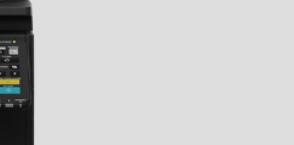




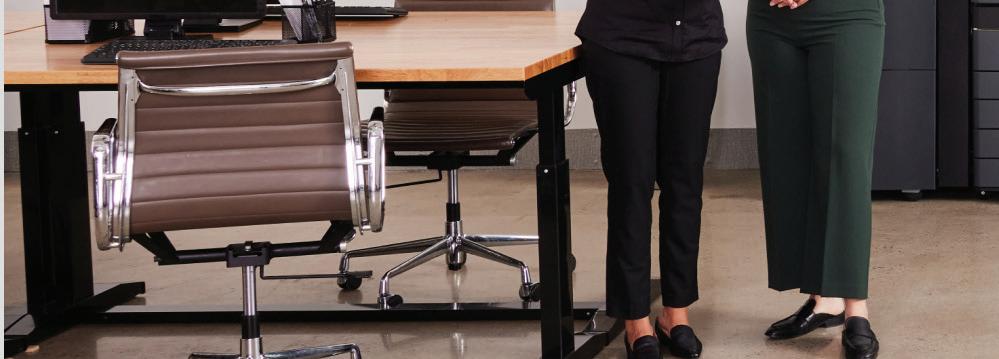

















Productivity and focus increase with printed materials. So, how can you optimize your print environment? Toshiba offers a wide range of e-STUDIO™ multi-functional printers that bring the right mix of speed, ease, and security to enhance productivity across your business operations. We understand that every business is unique, and that's why we offer customized solutions to help streamline any organization. Discover more at business.toshiba.com

inkjet devices? “There is no PM to speak of; I think the only thing we do is replace the feed tires once in a while,” Deluca says. “However, my per-copy profit is probably the same as the dealer who is selling laser. When you think about photoreceptors, fuser units and those kinds of things for laser, I don’t have those costs.”
Anyone who has been in the office technology industry for any length of time has heard industry veterans say something like: “I have toner in my blood.” Stephen Craig, president and owner of ONYX Business Solutions of Florida, based in Tampa, Florida, shares a variation of the industry veteran’s common claim: “Ink runs through my veins.”
It’s no wonder. Prior to acquiring his dealership, he worked at RISO Inc. for 25 years, starting as a service technician, later moving into sales and, ultimately, working as a regional manager. While ONYX does sell Xerox toner-based imaging devices, inkjet remains Craig’s passion. The dealership carries Epson, Formax and RISO inkjet products.
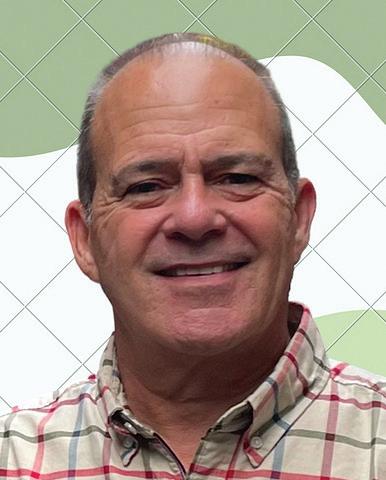
Craig’s enthusiasm and optimism for inkjet is crystal clear. Will we see a day when inkjet imaging devices are more predominant than they are today in the workplace? “Yes, we are just seeing a fraction of what they can do,” he says. “Looking back to the Epson dealer meeting in California earlier this year, when you consider their resources, what they are pushing and where they want to go with inkjet, I can see that it’s just the beginning. It’s going to explode.”
While there is now a new focus at ONYX to more aggressively sell Epson products into the general office, Craig notes that, until this year, the objective has been to sell into existing inkjet accounts. “Our focus with Epson placements has been in our traditional customers who identify with the advantage of proven ink-on-paper applications including verticals — education, faith-based organizations, print for pay and government,” Craig says. “We try to keep them with RISO, but the acquisition cost is a lot less with an Epson, which recently introduced 40-, 50- and 60-pages-perminute models for the office. With RISO you must have the volume to justify the acquisition cost; Epson gives you more flexibility with lower volumes.”
The message is the same to prospective customers no matter the inkjet brand. “In terms of the differentials between toner and inkjet, it’s speed, versatility [with the ability to print
on many substrates] and low cost of operation that really makes inkjet stand out,” Craig says. He illustrates inkjet’s appeal by citing a quick example of a RISO product used in a print-for-pay environment. “You can top load envelopes for printing, which exit onto a conveyor to be scooped up. You’re printing envelopes for a third of a cent or a half cent in full color. That’s $3 to $5 for 1,000 envelopes. Print for pays are selling those envelopes for $30 to $100. There’s good money to be made, and the RISO printer is fast and reliable.”
In terms of other benefits of inkjet over toner, Craig is particularly adept at explaining the appeal of the lack of heat with inkjet. “It gets warm almost everywhere in the United States, but would you put a space heater in your office in July or August?” he asks. “That’s what you do with a toner-based copier, because it’s a fire breathing dragon. So, not only do you pay for more electricity to cook toner pages like a turkey in an oven, but you are emitting heat; so, then you have to cool down the room.”
Craig is pleased with the profitability of inkjet. “We make very little off of a [toner-based] copier, whereas there is margin with inkjet, and the recurring revenue is what you need to make some money, keep the lights on and pay the bills,” he says. “The margins with inkjet are very, very beneficial.”
Why aren’t more dealers selling inkjet? Craig recalls from his days working at RISO that some dealerships would take on the product, but sales reps, fully comfortable selling toner-based products, would not learn how to sell inkjet. “Then it just sits there and the dealer says, ‘I’ve got this inventory and I can’t move it,’” he says. “It’s not that they can’t move it; they just don’t know how to move it. That’s why I benefit from Epson and RISO, because I know where they fit. Our experience with ink on paper allows us to demonstrate the benefits of inkjet while qualifying if this technology is best for the customer so as not to put a square peg in a round hole.”
Industry powerhouse Pacific Office Automation (POA), headquartered in Beaverton, Oregon, has 35 locations across 10 states. Founded in 1976, the dealership offers a broad range of imaging devices, including those from Canon, Brother, HP, Konica Minolta, Lexmark and Ricoh. POA has also expanded into such technologies as unified communications, security cameras and EV charging stations.
“There is no PM to speak of; I think the only thing we do is replace the feed tires once in a while. However, my per-copy profit is probably the same as the dealer who is selling laser. “
— Todd Deluca Boston Business Technology
DLL is a global finance partner for equipment and technology assets — committed to keeping your workplace up to date with the latest technology. We deliver sustainable and effective solutions to move assets to market throughout the entire asset life cycle: commercial finance, retail finance and used equipment finance.
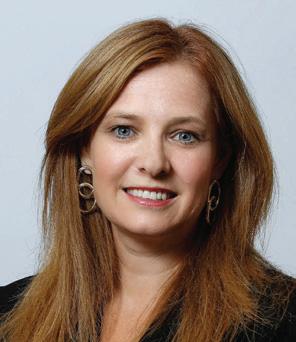
We understand the unique needs of our partners and have the right digital tools to simplify your sales processes and allow you to close deals from anywhere at any time.

Among the dealership’s broad range of product offerings are inkjet imaging devices from RISO and Kyocera. In fact, the two vendor partners are among the newest for POA. In 2020, the company acquired RISO of Sacra mento along with RISO’s San Francisco direct sales MIF. Then, in 2021, POA began selling the Kyocera TASKalfa Pro 15000c inkjet production printer, the only product it sells from the manufacturer.

Tom Kucharski, director of production at POA, provides in sight into the ideal environments for the two vendors’ inkjet products. Regarding the Kyocera 15000c: “The product is very, very good in the transactional print environment where invoic es are being produced or where they are printing something with a little bit of spot color on it. That’s the application for the
15000c in a nutshell.” Regarding RISO, he provides a specific example of the type of print job where the vendor’s products prevail: “Consider NCR three-part forms. Traditional laser technology struggles with these forms, due to the
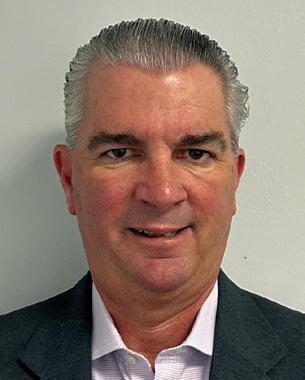
“ ... There is margin with inkjet, and the recurring revenue is what you need to make some money, keep the lights on and pay the bills. The margins with inkjet
the heat ... We’re finding that the number of prints between service calls are vastly lower with inkjet as compared to laser.”

Higher per-page costs on laser devices equate to “higher actual dollar margins,” but while there is lower revenue on the pages produced on inkjet devices, “our pricing model for the percentage of profits is the same, so, there is lower revenue, but the margins are good,” says Doug Pitassi, president of POA. “At 2 cents a page versus 5 or 6 cents a page, yes, I’d like more revenue because there are more dollars in the profit, but we are going for that high-volume hit with inkjet. Our reps find high volumes and convert those to a lower cost per page; the wins that we have had show that is exactly what is happening. That gives the customer an economic benefit and our margin on the total revenue is the same.”
It is surprising that more dealers are not selling inkjet, Pitassi says. “It has such a good quality; it’s good enough,” he says. “It is never going to be the quality that some picky graphics people expect in marketing companies and advertising, but in a lot of what we do out there, inkjet has a great quality. I’m just shocked that our people [in the dealer channel] don’t sell more of it.”
Kucharski offers a similar perspective, citing a specific example. “It’s funny to me that people are stuck on the fact that inkjet looks different in terms of quality when labeling envelopes,” he says. “I ask all the time, ‘Do you really think that people are looking at the quality of the address on the envelope?’ Ninety percent of the time they respond, ‘You know what, that’s a good point.’”
Pitassi advises dealers to consider offering inkjet if they are not already doing so. “In the right applications, it has its niche — and there is plenty of opportunity out there,” he says. “The technology is going to open doors for you that you wouldn’t otherwise open.” n
Brent Hoskins, executive director of the Business Technology Association, is editor of Office Technology magazine. He can be reached at (816) 303-4040 or brent@bta.org.

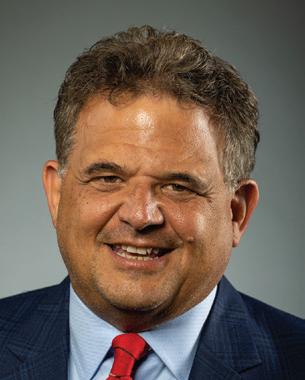
“In the right applications, it has its niche — and there is plenty of opportunity out there. The technology is going to open doors for you that you wouldn’t otherwise open.“
— Doug Pitassi Pacific Office Automation
After 40 years of launching, managing, scaling, selling and advising businesses, I have developed a sixth sense for knowing whether a business is destined for success or failure. In fact, it all comes down to a single factor. Best of all, this indicator is reliable regardless of market cycle, industry, management team, etc., and it is almost a comedically simple way to predict the trajectory of a company’s future at a glance.
But first I want to share a story. Early in my career, I worked at a company that had a great product, a handful of talented employees and a unique selling proposition (USP) that was strong enough for us to capture plenty of market share. However, the company was still missing something.
As a lifelong learner, I was always reading books, taking workshops and hiring the best coaches I could find to ensure I could compete at the highest levels. So I was shocked when I discovered the company did not have any training programs. Essentially, there was no way to gain education, develop skills or grow.
This was perplexing, because even if the company was able to catch some early success by properly timing a product or two to market, I wondered how it expected to remain a top-tier organization without embodying a culture of training, development, knowledge acquisition and success. Without structured training, the company was relying on luck.
Since I knew it was virtually impossible to build an organization on that type of shoddy foundation, I spoke with the other partners and asserted how vital it was for us to make some changes and to invest in our people. After I met some mild resistance, I finally got the go-ahead and we began developing training programs.
Before long, the other partners noticed how many resources we were putting into the program (which were significant) and they got nervous about the expense, time investment, etc., necessary to make something really powerful. Finally, one day one of the partners could not take
it anymore and said, “What if we spend all this time and money training them and then they leave us?”
I replied: “What if we don’t train them — and they stay?”

Educated employees can take your company to new heights, whereas uneducated employees can destroy it. A few months after that conversation with the other partners, we had a robust training program for the various teams in the business and we even held an optional four-hour sales training once a month on a Saturday morning.
For more than two years, roughly 80% of the employees voluntarily attended those trainings and the company went on to become the number-one retailer in the country out of more than 500 other competing retailers. It is not that there was anything particularly magical about the training; it was because of how instilling a culture of education, knowledge and success rippled out and improved every other aspect of the business. In fact, we may have been onto something well


ahead of the curve because, recently, LinkedIn shared that “94% of employees would stay with a firm longer if it invested in their learning and development.”
There is a reason that all of the largest, most successful companies in the world invest a tremendous amount into their R&D budgets: They are the mechanism by which you seed success for a company’s future. So, if your company does not have an R&D budget, at a minimum, it needs an education budget.
When employees receive elite training, they are far more likely to remain engaged, curious and succeed more in their positions, which only begets more motivation to keep growing. In fact, Axonify found that 92% of employees said wellplanned employee training programs have a favorable impact on their level of engagement.
When you foster this type of environment, it produces an
upward spiral of momentum and makes things like accountability, quotas, etc., almost redundant. When intelligent people are given the tools and resources they need to flourish, on top of creating an environment that pushes them forward, everyone either starts to perform or they leave the company. Essentially, training programs ensure that employees are having big wins, small wins or wondering what else they need to learn to create more wins like everyone else.
On the flip side, when employees are not trained, they can tell that you do not really care about them or their success. So, they respond accordingly. Why should they care deeply about the company’s success when the company does not care about their personal success?
Without training, employees can become disengaged (aka “quiet quitting”), they can damage sensitive customer relationships (like when they voice their frustrations to customers during interactions) or they may even be so frustrated with the lack of progress that they will try to prevent other high achievers from going the extra mile. If left unchecked, eventually no one will want to work in that type of environment. This can even reach the business owner, making him (or her) resent the very business he started. This downward spiral of negative momentum makes everything a drag, often to the point where it is virtually impossible to inspire the innovation necessary to keep the company thriving.

As the business owner, it is ultimately your job to see the vision and to find ways to align an employee’s personal success with the company’s overall success. This is where training comes in. It is how you incentivize your team members to invest more of themselves into self-improvement so the business benefits because of their personal growth.
You don’t get more out of people by “squeezing them harder” (at least not intelligent people) but, instead, you get more out of people by building them up. You increase their capacity for output, which improves their futures while it enhances the company itself.
Simply put, when you have educated employees, your company grows. This gives you and your team more opportunities to capitalize on, which is how you grow your impact, create “career paths” and expand your business.
Additionally, it keeps your team leaner, because well-educated employees find smarter, more efficient ways of solving customer problems — which is exactly the culture you want; where they will naturally innovate faster than competitors.
Most importantly, it also attracts a different caliber of
As the business owner, it is ultimately your job to see the vision and to find ways to align an employee’s personal success with the company’s overall success.
Marvin
Copier Dealers across the country have successfully added water dispensers as a natural product line extension for their existing business.
Pure Water Technology® o ers a comprehensive program to help YOU become SUCCESSFUL in the multi-billion dollar B2B drinking water industry.
Benefits:
Increased customer loyalty
High profit recurring revenue model

Low cost of entry
Sales and marketing start-up kit
Financing options

person during the hiring process. Anyone with a “growth mindset” (as compared to a “fixed mindset”) will be attracted to companies that reward initiative, growth and creativity. A robust training program advertises the values of the people you want to attract.
Our shorthand for this type of person is referred to as a “20,” and he can be spotted easily through the “seven attributes of successful people,” which we wrote about in “Hiring & Mentoring” in the May 2022 issue of Office Technology.
A note here: You do not just train someone once and assume that it is all finished. Human beings need to be trained and retrained. That is why we recommend you carve out an education budget.
There is no substitute for live training facilitated by highly experienced experts, which is one reason why we offer more than 35 in-person trainings per year across all areas of business (sales, operations, financial management, HR, technical, etc.) specifically tailored to managed print services, MSP (managed service provider) and IT companies.
However, as mentioned earlier, repetition and “ease of access” play a huge role in whether or not training is embraced. Like most companies, at Technology Assurance Group (TAG), we are big proponents of learning management systems (LMS), which not only put all employee trainings in one convenient place that can be accessed from anywhere, on any device, at any time — but also track employee progress so owners can monitor which trainings certain employees have completed.
From a management perspective, every time a technician achieves a certification, he is immediately compensated with a financial bonus (like a $100 to $200 bonus check) and we note this type of initiative with HR. When annual/quarterly employee reviews come around and there is an opportunity for a long-term promotion, an employee who has demonstrated his desire to grow is much more likely to get the new position, the raise, the additional responsibilities and/or be seen as a potential leader for the future.
As far as “ease of access” is concerned, there are all sorts of mechanisms available to make training convenient and accessible so employees can learn with minimal friction whenever they want to increase their skills.
At the most basic level, there is always YouTube, with plenty of IT channels like ProgrammingKnowledge (https:// www.youtube.com/user/ProgrammingKnowledge) to check out. Typically, if you have a “20” on staff, he will know which
channels are best suited to him already and you should elicit that information from him. At the end of the day, you want to empower your staff members to take the initiative in their self-development.
We are also big advocates of more advanced and sophisticated IT training services. An example is ACI Learning’s ITProTV (https://www.itpro.tv), which keeps training very flexible while also providing structured courses with training tests, peer groups, Q&A forums, etc.
Regardless of detail, the greatest way to inspire self-improvement is by paying for employees to train on your dime. This means you need to make training part of their work, not just an extra opportunity. When getting started, we recommend that you give employees two hours per week of paid time for training on whatever subjects they are interested in. This is a great way to find out where they want to take their careers and how you can match company opportunities to their natural interests.
Training is about so much more than merely increasing profits, but it is important to underscore that, ultimately, more training means more profits. Deloitte estimates that “comprehensive training leads to a 218% higher revenue per employee” and the American Society for Training & Development notes that “when employers spend $1,500 per employee (per year) on training, their profit margin increases by 24%.”
Maybe this is why it feels like it is the right thing to do. When we educate, guide and teach others, it uplifts everyone involved. Employee training helps us build stronger organizations, increases profitability and creates an environment that appeals to everyone. n
Dale Stein is co-founder of Technology Assurance Group (TAG), an organization of managed technology service providers (MTSPs). Collectively, TAG’s members do $800 million per year in IT, cybersecurity, telecommunications and video surveillance. They are located in 148 cities across the United States and Canada, and are presently serving more than 780,000 SMBs. He is responsible for developing TAG’s strategic planning and guiding its business development. In addition, Stein is the managing partner for TAG’s MTSP, i-NETT. He is responsible for i-NETT’s daily operations and serves as its president. Stein also founded Westec Security Corp. and served as its CEO. He can be reached at dales@tagnational.com.
Visit www.tagnational.com.

... The greatest way to inspire self-improvement is by paying for employees to train on your dime. This means you need to make training part of their work ...
In the evolving landscape of Managed Print Services, specialization is key to success for partners and customers alike. At Kodak Alaris, all we do is deliver world-class document capture solutions, and we do it better than anyone in the world.
The only manufacturer that offers a full range of scanners, software, and services.
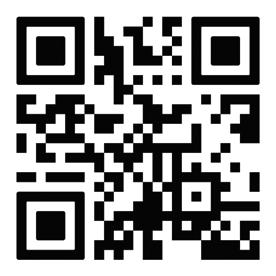

Providing lucrative channel programs, including deal registration, spiffs, trade-ins, and more.

Your trusted partner/extension of your sales teamWe identify synergies among MFP and scanner technologies to deliver a uniquely customized workflow for business optimization.
We are channel-driven and here to support you. Visit our site to see the difference: info.kodakalaris.com/see_the_difference_partner
Whether we blame the COVID-19 pandemic, the current performance of the economy or the job market, customer service is quickly becoming a dying art. Many businesses prioritize efficiency over the customer experience as technology evolves, leaving customers disconnected and dissatisfied. Despite this growing trend, customer service is critical for business growth and success. By removing the barriers to great customer service, businesses can create lasting relationships with their customers that will ultimately lead to increased revenue and customer loyalty. In this article, I will discuss why customer service matters, a few of its principles, provide ways to remove the barriers to achieving great customer service and how my company, Smart Technologies, keeps it central in our culture.
You can see the technological transformations in your neighborhood grocery or home improvement store with the rollout of self-checkout aisles. The changes can be spotted in automated interactive voice response (IVR) phone systems with “Opus Number 1” on-hold music and touch-tone options. With every new day, more and more companies rely on automated solutions for basic customer tasks and workflows. As a result of this shift to digital tools for customer service, the “front-line employee” has gone away.
And who can blame companies for looking to these solutions? Early retirement, low immigration and a pandemic have made a labor market shortfall of 3.5 million — and it shows no signs of slowing down. Just in the last 12 months, there has been a decrease in available customer service positions by 4%. Businesses are left searching for new technologies to fill the human-shaped holes that were occupied just 24 (maybe 36?) months ago.
Yes, customer service still matters. In the digital age,
where customers can quickly access information or purchase a product without speaking to someone in person, it is easy to assume that customer service is no longer relevant. But nothing could be further from the truth. More than 70% of buying experiences are based on how customers feel they are being treated. Customers who receive timely and helpful responses are more likely to return repeatedly, making customer retention a more cost-effective action than new-customer acquisition. Moreover, excellent customer service shows customers they are valued by the company, making them feel like an important part of their success. It creates trust between businesses and their clients, increasing lifetime value and building stronger relationships.
Now that we have solidified the importance of customer service, let’s dig into what it is made of. While several factors play a role in great customer service, mastering the principles below is most critical:

(1) Empathy matters — You and your team should recognize the importance of empathy in customer service; it is worth its weight in gold. Empathy allows employees to understand customers’ perspectives, improving the overall customer experience and elevating satisfactory customer service to great customer service. It is an invaluable asset in any successful business. Henry Ford said it best: “If there is any one secret of success, it lies in the ability to get the other person’s point of view and see things from his angle as well as your own.”
(2) Provide clear and effective communication — When looking to improve your customer service, it is essential to provide clear communication and have a deep understanding of the services that inspire customer trust. Also, the ability to break down complex issues into easy-to-grasp concepts will prevent any confusion or misunderstandings from occurring while ensuring clarity throughout
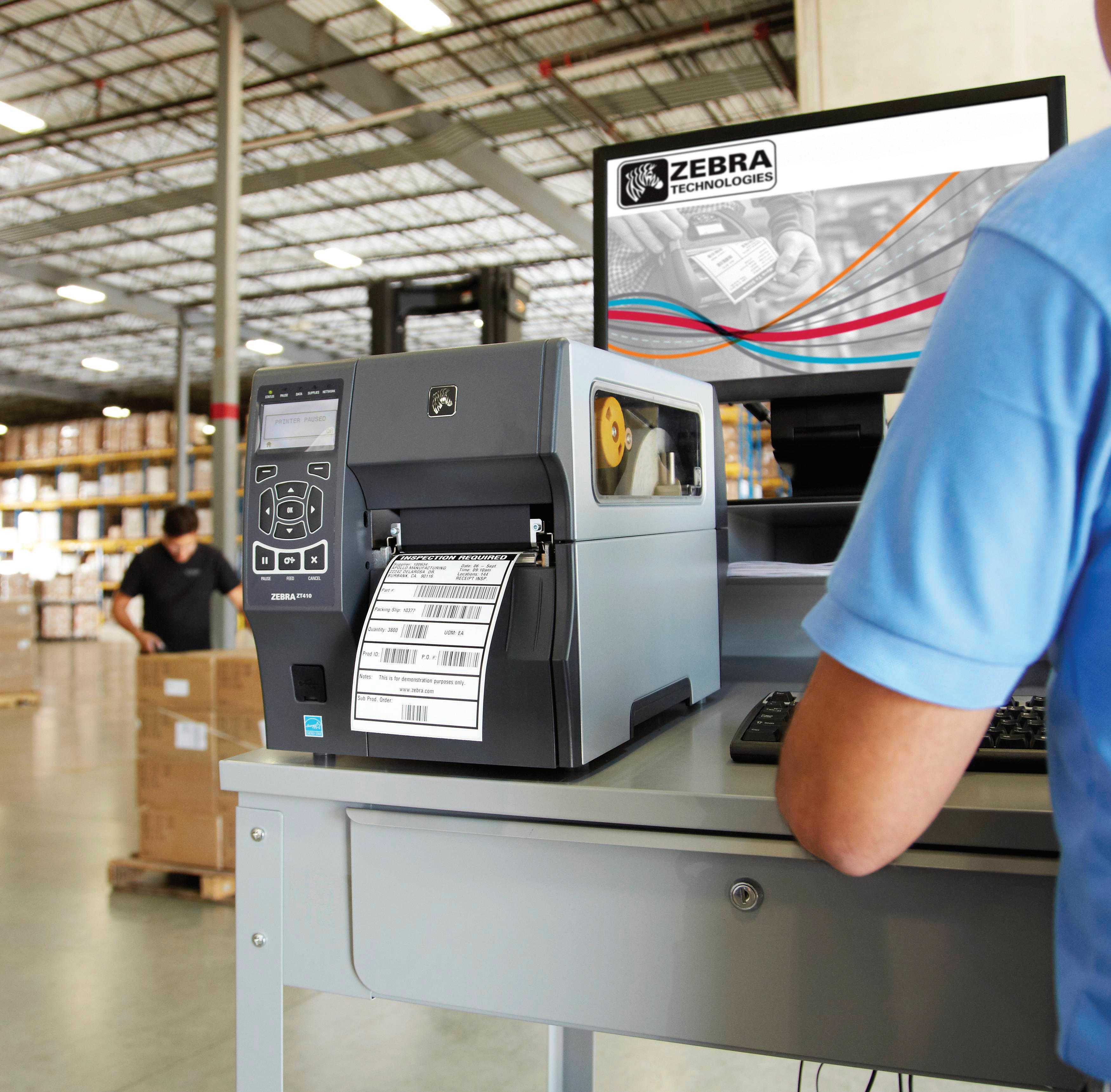
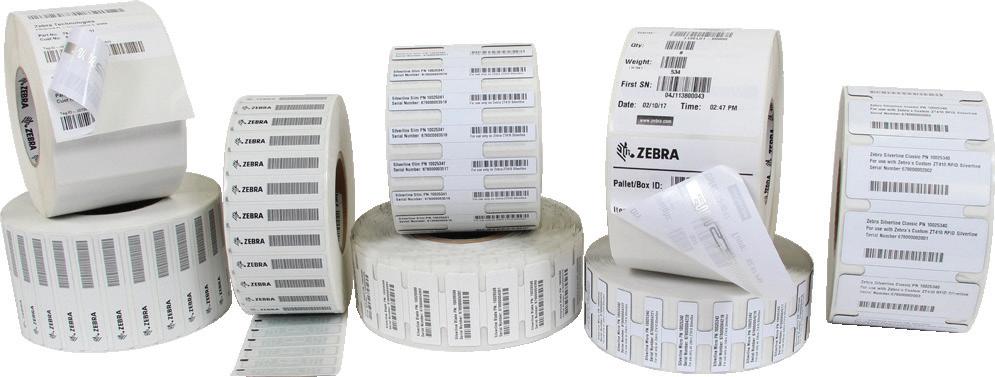
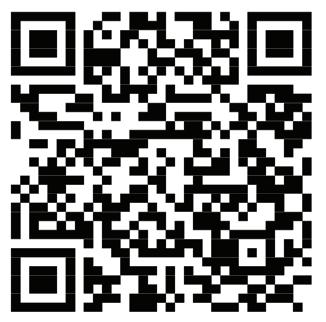
the troubleshooting process. Utilizing positive language when communicating with your customers reinforces efficient problem-solving by focusing on what you can do instead of what cannot be done, allowing for effective solutions that leave little room for frustration.
(3) Responsiveness — In customer service, speed wins. According to customer-experience research firm Forrester, more than 71% of customers think valuing their time should be the top priority for a business in terms of providing good customer service. However, responsiveness in customer service is about finding the right mix. Striking the right harmony between a quick resolution and thorough problem-solving can be tricky, but it is essential to ensuring customers remain satisfied. When your staff focuses solely on response speed without evaluating needs in-depth, overall service quality suffers.
Knowing how to provide great customer service does not help a single one of your customers unless you remove the barriers to providing it. Let’s dive into some simple actions you and your team can take.
(1) Customer service is reactive; customer experience is proactive — Customer service is a reactive effort to address your customers’ immediate inquiries and concerns, while the customer experience is a long-term process designed to create a lasting impression on customers. Both play critical roles in how your customers view your business. Still, by improving your customers’ experience, you can anticipate potential challenges they may face and develop proactive strategies for meeting their needs.
(2) Make customer service a business priority — As Jeff Bezos said: “It’s our job every day to make every important aspect of the customer experience a little bit better.” Customer service should be a top priority for your team, as it is an essential ingredient of success in any industry. To make customer service a core part of your business process, you must create a customer-centric culture from the ground up. This could include setting service standards, training staff members to deliver customer-driven experiences, providing a convenient customer support system, creating customer rewards programs and more.
(3) Trust but verify — You have given your team members the tools to provide great customer service; now is the time to verify they are hitting the mark. To do this, implement customer satisfaction surveys and feedback systems that allow customers to provide assessments of their service experiences directly. Additionally, consider regularly monitoring
customer interactions for quality assurance and providing customer service training for team members when necessary. Taking these steps will help ensure customer needs are met and their expectations are exceeded.
(4) Align your tools to support human interaction, not replace it — Today’s business operators can look around almost every corner and find a tool to optimize or automate a business workflow. However, you should look to automate with human-centered service in mind. If the workflow process replaces an opportunity to interact with your customer personally, it might not create customer delight.
A great example of leveraging technology that helps — not hinders — creating great customer service is Uber. Uber leveraged technology to disrupt the taxi service industry while maximizing the customer experience by:
n Removing the friction of booking a taxi through traditional methods
n Providing clean vehicles with a pleasant driver experience
n Handling pricing and payment in a clear, transparent way
n Enabling an immediate way to provide customer feedback
Providing an exceptional customer experience requires companies to walk the talk. This means putting as much effort into delivering on promises and resolving issues as they do in any other facet of their companies. Here are a few realworld examples of how Smart Technologies keeps delivering great customer service central to our mission and culture:
(1) Face-to-face customer interaction from the start
We make it a priority to start our first interaction with a customer in person. We understand the value and insight we gain by seeing the needs of our customers face-to-face. Throughout the entire Smart Start with our clients, we make sure to keep it a human-centered journey.
(2) Frequent and consistent customer review cadence
A core customer service policy we require our team members to provide for every client is a quarterly one-on-one meeting. This gives us an opportunity to review the solutions we have provided, as well as uncover any opportunities to improve our service. Creating a constant customer feedback loop gives us the data we need to regularly improve.
(3) Responsive support through our Smart Portal — We created Smart Portal to provide a convenient way for our customers to request support or troubleshoot issues with print and document management. Customers can create a ticket in any way that is convenient for them — online, via email or by phone (yes, a direct line to a real-life human).
To make customer service a core part of your business process, you must create a customer-centric culture from the ground up.



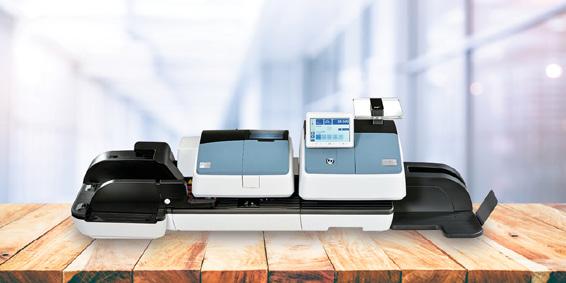



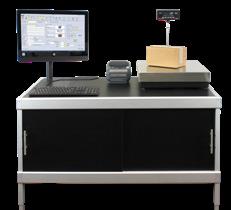


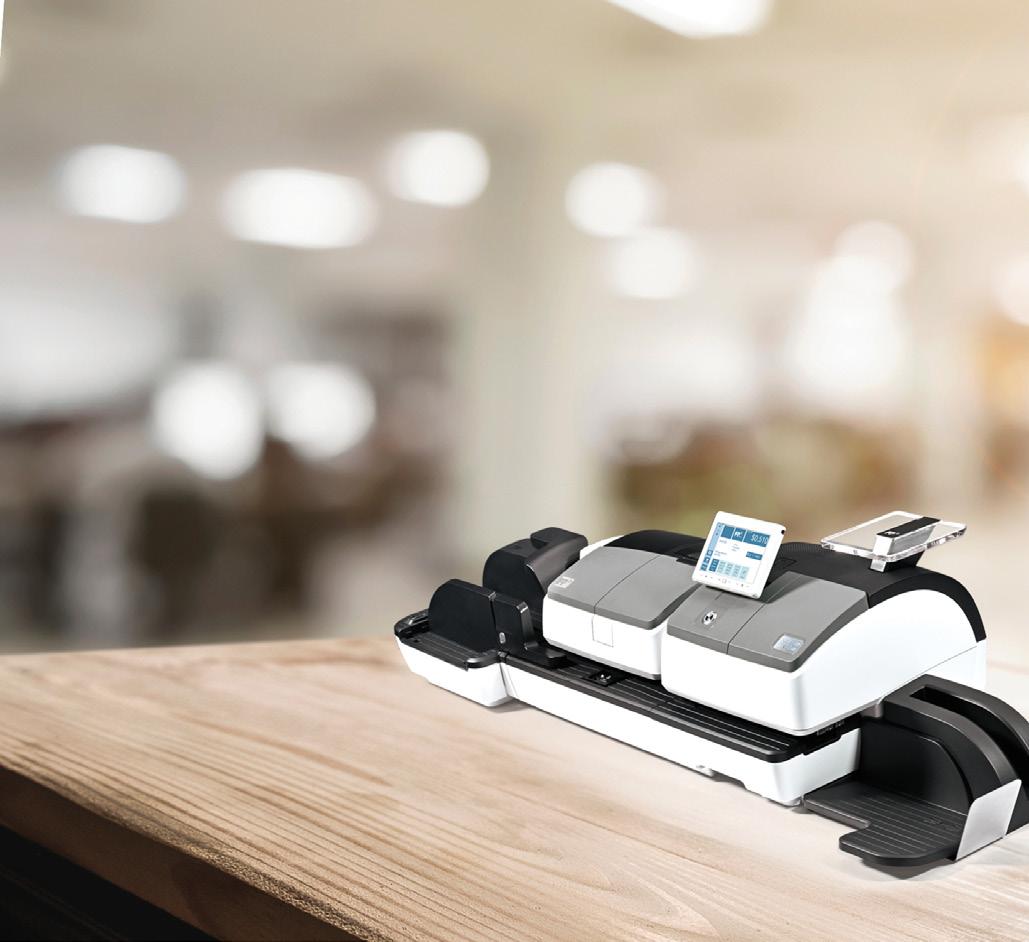




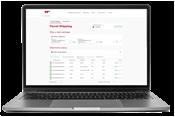


Our portal also provides innovative tools our support staff can use to provide immediate, responsive support.


(4) Proactive tracking and analytics — Our managed print and document solutions incorporate device and usage tracking to proactively monitor for potential service issues or repairs, minimizing the need for customercreated support requests. This allows our customers to continue their day-today workflows without needing to constantly check device health and usage stats.

In conclusion, customer service is still a critical factor in business success. Front-line employees may have changed over the years, but the basic principles of customer service remain unchanged and are essential for businesses to build trust with their customers. You and your team members must take steps to remove any barriers that prevent providing

great customer service by recognizing the importance of a well-trained team, creating systems for efficient communication management, and investing in digital solutions that help you stay connected with your customers. By implementing these strategies, companies can ensure they are walking the talk regarding delivering excellent customer service that continues to delight. n
Robert (Bob) Doucette is president of Smart Technologies of Florida. As a trusted technology partner for more than 23 years, Smart Technologies helps businesses achieve their most important goals and fulfill their purpose in the world by leveraging the power of machines, technology and people.

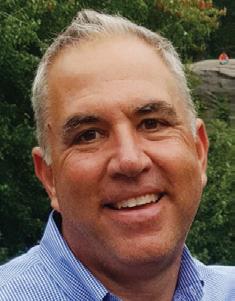
He can be reached at rdoucette@smarttechfl.com or (866) 90-SMART. Visit www.smarttechfl.com.

Front-line employees may have changed over the years, but the basic principles of customer service remain unchanged and are essential for businesses to build trust ...

Compiled by: Brent Hoskins, Office Technology Magazine
Recently, Office Technology magazine interviewed Ron Petrucci, vice president and general manager of the Katun North America Business Unit (Katun). Founded 43 years ago, Katun is a leading provider of OEMcompatible imaging supplies, photoreceptors and parts for MFPs, printers and other imaging equipment. The company serves 10,000 customers in 116 countries from its headquarters in Minneapolis, Minnesota, and from its dozens of additional locations worldwide.
Petrucci joined Katun in July 2018 to serve in his current role. He leads the office equipment and office supply channels in North America with a track record of increasing revenue and organizational profitability during his 25-year imaging industry career. Prior to joining Katun, he held leadership positions at several office technology industry companies, including Clover Imaging Group and Panasonic Office Imaging. He also served as president of both Kyocera Mita and Danka Ominifax. Petrucci holds a Master of Business Administration in marketing from Arizona State University.

Below are seven of the questions Petrucci was asked and his responses.
OT: Please provide an overview of Katun in terms of its history, scope and growth through the years, and its current range of product offerings.
Petrucci: Forty-three years ago, Katun emerged as the innovator for the aftermarket in the A3 arena. Since that time, it has become a worldwide leader. Today, the company is owned by GPI [General Plastics], based in Taiwan. We are a debt-free, very profitable organization.
In terms of product offerings, our core business is primarily toner and parts for the A3 and A4 business. We are also involved with surge protection, MPS software and a
number of other affiliations with companies that do statistical analysis for dealers, and we offer various programs tied into that. We also now handle a full range of OEM products, in both the A3 and A4 spaces.
In terms of the OEM-equivalent products that we offer, we have made many improvements over the years. We use our own proprietary testing methodology and have $10 million worth of testing equipment. We have a 50,000-square-foot facility that is used for R&D and QC. That is how we differentiate ourselves; how we develop our products is unique to Katun. We have our own formulas and, with all of our testing, we do not release anything until it meets OEM standards.
OT: The Katun website states that the company “pioneered and helped legitimize the imaging supplies aftermarket.” Please comment on that claim.
Petrucci: We were in uncharted territory 43 years ago, developing the first A3 aftermarket toners and parts. Over the years, we kept developing greater standards for ourselves. Today, our products have become the industry standard in the aftermarket, especially in the A3 arena. Katun is now a household name in the dealer community.
OT: What is your assessment of the growth and acceptance of the non-OEM parts and supplies market through the years? Has that level of acceptance plateaued?
Petrucci: Katun has seen dramatic growth for the last probably five years and, within that, there is a greater level of acceptance in terms of the Katun OEM-equivalent products. However, I think that with the economy and all the changes that have gone on, it just opens up the door for the dealers


who want to gain more profitability in their dealerships and, so, that acceptance is somewhat financially driven. Then, once it is proven, that acceptance grows in the form of “we should order more.”
Has it plateaued? No, I do not think so, because more and more dealers are still looking for ways to improve their businesses to make up for the loss of clicks and to just gain more profitability.
... They found out that ... these products worked just like those from the OEM ... So, within that, the dealers are increasing their margins and their profitability.
I ask dealers, “What is right for your dealership?” The manufacturers tell them: “Just use all OEM.” Again, the question is: “It is right for your dealership or not?” They are independent dealers, so they need to make independent decisions about what is right for their dealerships. So, again, no, I do not think it has plateaued, because dealers are always analyzing how they can improve their businesses and their profitability.
OT: What can you share about the range of support and educational programs/initiatives that Katun offers its dealer customers?
Petrucci: There are quite a few. One of them is our Katun Platinum Plus program. Within this program there is allocated financial support and an annual fund that the dealers can utilize for other investments in training and education. We also have a technical alliance program called K-TAP. Through that we offer product training — both detailed, inperson training and webinars for a dealership’s technical staff members.
We also send out educational documents. For example, we may send out an alert that certain firmware changes have occurred. Or, if there are changes within our products or improvements in the quality standards or testing of our products, we will send that information out to the dealer community.
In addition, we run a variety of promotions and incentives that go out monthly. For example, if a dealer has not ever ordered a certain product from Katun, the dealer will get discounts on the front end to try it. There are always promotions that we are doing to enhance dealers’ profitability.
OT: What do you see as the primary challenges for office technology dealers today? In what ways is Katun helping dealers address some of those challenges?
Petrucci: The dealer community has done an effective job at managing chaos in recent years, as we went from the COVID-19 pandemic to supply-chain issues. Beyond that, there are a lot of challenges that are ongoing. For example, there are now more people working from home and schools
are doing remote learning, so many people are not printing as often. The level of clicks is not coming back to where it was in 2019.
So, there is a lot going on with dealers today, which involves rightsizing, efficiencies and operations. What does a dealer do in terms of trying to effectively do a good job for his (or her) customers when, today, the customer is paying $250 for a lease and — with inflation and increased lease rates — pays $350 after an upgrade? It becomes a major issue.
There is a finite number of elements the dealer can work with — equipment, parts and toner. So, from our side, in order for dealers to be more effective and increase their profitability, we have counseled and worked with them to blend their OEM purchases more effectively with Katun purchases. That allows them to increase their profitability and assists in the areas where their margins are squeezed and the clicks are being reduced.
Through the pandemic and with the challenges mentioned earlier, some dealers who had never ventured into the OEM-equivalent marketplace were forced to because they did not have product. When they did so, they found out that, at least from the Katun standpoint, these products worked just like those from the OEM. There was a revelation in terms of the dealer community that not only do you get these massive discounts, but it works. Previously, some technicians, service management and executive management likely thought: “Yes, it’s more affordable, but it’s not going to work.” Now they found, with certainty, that it does work. So, within that, the dealers are increasing their margins and their profitability.
The other thing that Katun has played a big role in is through the acquisitions within the marketplace. Katun plays a massive role in the ROIs for the dealerships that are acquiring. So, they acquire, plug in and blend Katun into that equation, and the profitability of the dealership they have just acquired changes. So, they recoup or get their return on investment much more quickly by blending in Katun.
OT: Based on your many years in the industry, what is your assessment and observations of the strengths of the dealer channel today?
Petrucci: The dealer community, in my opinion, is as strong as it has ever been. In fact, I would say stronger in terms of the core competencies within dealerships. Plus, dealers are expanding and diversifying into other areas that will increase their profitability and increase the scope of


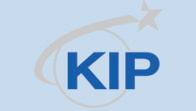


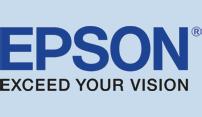
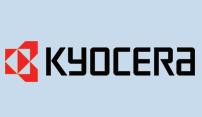




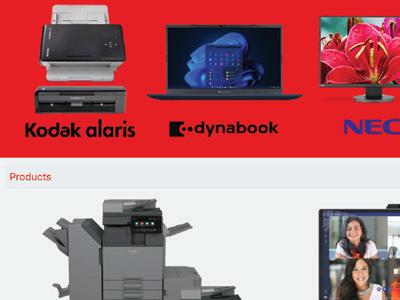

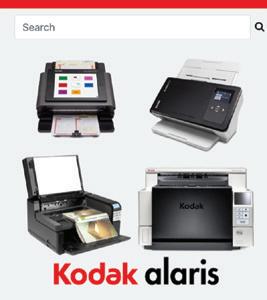



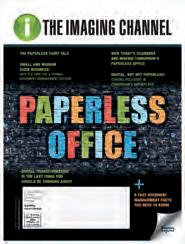
C2C Resources has helped over 35,000 businesses collect over $380 million in past due balances.
PARTNERSHIPS DESIGNED with your profitability in mind.


No Upfront Fees
Faster Remittance
Free Legal Forwarding
Increased Recovery Rates
FREE Profit Maximizer Web-Based Software
Since 2002 C2C Resources has specialized in bad debt recovery using innovative technology and the most sophisticated collectors and investigators in the industry. C2C is fully licensed, bonded, and CLLA Certified.

For information, please contact Sven Nelson at 866-341-6316 or snelson@c2cresources.com.
BTA Partner since 2006.
their dealerships. That is what I see.
The other thing that I see is a lot of consolidation. There is a model for that, which is not atypical, perhaps, within a mature industry. However, I think smaller dealerships should stay the course, sticking to their formulas and within those formulas. Whatever the niches they are operating in, they should stick to them and grow their businesses accordingly.
There are variances in the marketplace — very large dealerships and some that are very small. Some of the smaller ones are being acquired. However, I think there is room in a capitalistic market for these smaller dealerships to grow effectively. If we look back at the Danka and IKON days, many people said: “Oh, the small dealerships are dead. How do we compete against some of these larger firms?” It has been proven that you certainly can do that and grow your business effectively.
OT: What significant changes do you believe we will see in the industry and the dealer channel in the months and years to come?
Petrucci: Some of the trends we are seeing today will continue for a period of time — that is in both consolidation and diversification. I think security is a strong area that will continue to grow. What I think we do not see enough of today — and this is the magic formula — is the practice of taking a look at the core competency of a dealership. What products or services are there in the marketplace that will complement a dealership’s core competencies? I think that is naturally where the dealer channel is going to flow.
Years ago, I was president of Danka Omnifax, a facsimile company. We could see email was coming in and so forth, so we looked at our core competency at that time. We had nationwide service and centralized billing. What could we plug into that to make us successful in the future? I think the same scenario holds true with the dealer community today in analyzing where dealers can go and how they can be successful. Dealers should look at their core competencies and determine which products fit best for them. n
Brent Hoskins, executive director of the Business Technology Association, is editor of Office Technology magazine. He can be reached at brent@bta.org or (816) 303-4040.
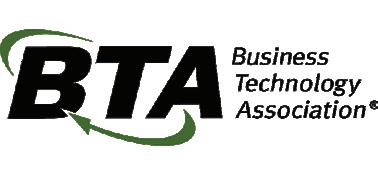
... I think smaller dealerships should stay the course ... Whatever the niches they are operating in, they should stick to them and grow their businesses ...
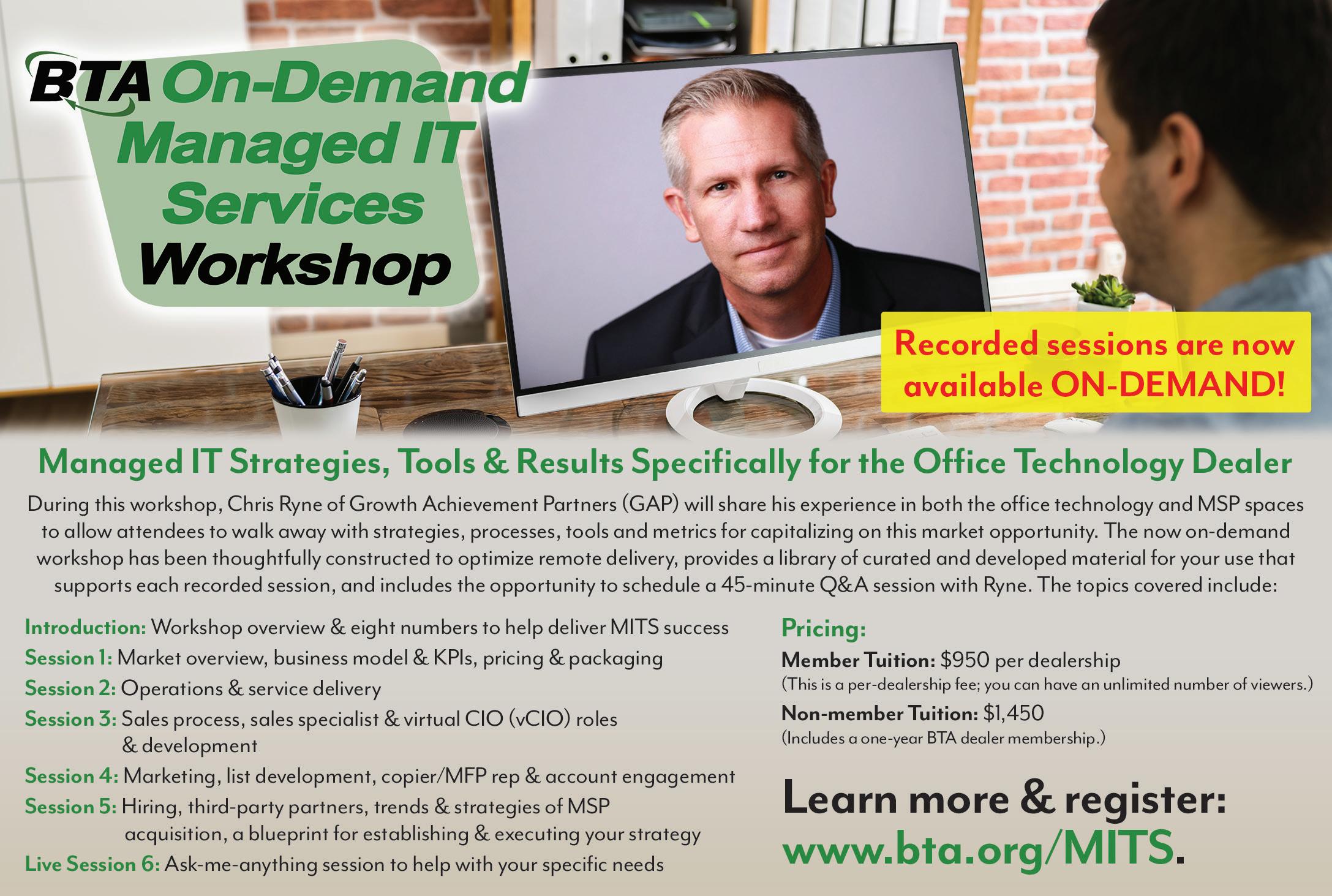

 by: Brent Hoskins, Office Technology Magazine
by: Brent Hoskins, Office Technology Magazine

Sharp Imaging and Information Company of America (SIICA) hosted its National Dealer Meeting April 18-21, 2023, at the Wynn in Las Vegas, Nevada. Themed “Opportunity Meets Execution,” nearly 1,000 attendees — including nearly 600 Sharp dealership personnel — gathered to learn about the company’s new and upcoming products, solutions and programs. The meeting featured two General Business Sessions, 14 Breakout Sessions and a Product Showcase, which highlighted the Sharp product lineup as well as third-party vendors in a space nearly 30% larger than any previous Sharp meeting.
John Sheehan, senior vice president of channel sales at SIICA, welcomed attendees as the opening General Business Session got underway. He was quick to address the challenges the industry has faced since the last Sharp National Dealer Meeting, which took place in 2019. “Hopefully you felt, in those three years, that Sharp was present, that it was a good partner; we didn’t disappear,” he said. “We were there with you through the tough times. Obviously, we’re going to be there through good times.”
Sheehan also commented on Sharp’s performance during the supply-chain crisis. “We had a lot of product, right?” he asked the audience. “We were definitely in a good position with product; that made a huge difference. To be fair, the others did not. They didn’t invest in this business, but we did. We had product. We were on a growth path long before 2019, but during those crazy times, part of our goal was to get as much product to as many dealers as possible.”
In his presentation, Sheehan also emphasized Sharp’s market share growth in recent years. “We’ve had amazing growth since 2019,” he said as he shared a slide revealing that Sharp’s U.S. MFP A3 unit market share increased from 7.2% in 2019 to 10.1% in 2022. “Together, we have reached our highest point in market share.”
In the opening General Business Session, Mike Marusic, president and CEO of SIICA, thanked Sharp’s dealers for their role in the company’s growth. “I want to thank you for your support,” he said. “It’s been a crazy three years. It’s really been absolutely insane, and I can’t say enough about how wonderful the dealer community, all of you, have been throughout it all. You’ve been so supportive of Sharp, supportive of our business and supportive of the industry.”
Through the challenges of the pandemic and supply-chain crises “there’s one lesson we’ve all learned over the last couple of years and that is: This is one resilient industry,” Marusic continued. “This industry can stick through anything. I know
there are a lot of questions out there about what’s next. What’s going to happen? What’s the future for our business? We see many of the same challenges you see ... but, honestly, I still see a tremendous amount of opportunity in this business.”
That optimism was revealed in the various product announcements at the meeting. Perhaps chief among them was the announcement of the six-color, 120-pages-per-minute (ppm) Sharp Digital Color Press Series, offering real-time color stabilization and inline finishing options including square fold, crease, a two-edge trimming module and a variety of folding options. Two monochrome digital presses, printing at 136 ppm and 125 ppm, were also announced.
Among the other announcements/previews:
n New Pro Series light production models, printing at 70/ 75 ppm in color/monochrome and 80/80 ppm in color/monochrome, which will replace the current models later this year
n A Sharp and ConnectWise collaboration, with a security and event management (SIEM) service as the first deliverable
n A refresh of Sharp’s A4 MFP and printer solutions, starting in late spring, with A4 color devices that provide professional-quality output in a small footprint
n A new line of 4W-B series value-priced AQUOS BOARD interactive displays
“Over the next two days, we hope to demonstrate our commitment to you and to the market in general,” Marusic said as he concluded his presentation. “My hope is that you’ll see a company that knows what it wants to do, knows how to do it and has a plan to execute it.” n
Brent Hoskins, executive director of the Business Technology Association, is editor of Office Technology magazine. He can be reached at brent@bta.org or (816) 303-4040.

For more than 30 years there have been entities purchasing office technology dealerships. Unlike companies in many industries that do not have exit strategies, office technology dealers clearly have options. Although there is no set formula to establish a purchase price for a dealership, the amounts buyers have paid have steadily increased over the years. If that constant rise in prices is actually a bell curve, do dealers now face lower values? The costs to buyers have increased thanks to higher interest rates and the result has been a corresponding decline in multiples of earnings before interest, taxes and amortization (EBITA) expenses.
The reasons for selling a dealership are highly individualized. But whatever the reason, once you have reached the decision to sell your business, the question is: “What comes next?” The sale of your dealership will perhaps be the biggest business transaction of your lifetime. So, before you consider selling, it is important to understand the nature of the sales process, the timetable that is likely to be involved, and the preparation that is required for the ultimate result to be successful.
Selling a business is an elaborate process, not an event. It generally takes three to four months from preparing for to closing on a sale. There are significant rewards to be obtained if you spend the time and money to develop a compelling story that will be attractive to sophisticated buyers. This includes compiling the data that buyers will want to review, validating financial results and presenting the company’s potential in the best possible light. Involving more than one buyer in the process is likely to enhance the perceived value of the business. Interest among several viable buyers provides you with negotiating leverage and, ultimately, yields the best price. There are many different facets of the sales process. If you attempt to do it without help, you will experience great stress and likely drop some balls. You have built a viable, thriving business and there are too many questions for one person alone to answer. You should bring highly trusted employees into the sales process and clearly communicate why the transaction will be good for the company and its team members. Putting financial rewards in place can ease employee concerns about life after the transaction.
Finally, you are more likely to get an optimal result when you retain professional advisors who understand the industry, who are able to source the best potential buyers to purchase the business, and who can present the company in the most favorable light to these buyers. There are many qualified individuals in our industry who can serve as advisors.

Selling a business is a big deal and it should be approached in a strategic, coordinated fashion with the understanding that it will require a tremendous amount of effort. Gathering all the necessary information will keep you occupied for many days and nights. Navigating through unfamiliar waters when the stakes are so high produces a high level of stress.
The good news is that there is a proven path to success and experienced individuals who are available to help along the way. The end goal will be worth it if the sales process is handled in a manner that allows you to realize a substantial financial reward for years of effort and sacrifice. Reach out to fellow dealers who have sold their businesses and gain their valuable insight into the dos and don’ts. The Business Technology Association (BTA) is a valuable resource as well. n
Robert C. Goldberg is general counsel for the Business Technology Association. He can be reached at robert.goldberg@sfbbg.com.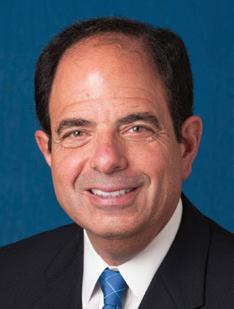
BTA would like to welcome the following new member to the association:

Drexel Technologies Inc., Lenexa, KS
For full contact information of this new member, visit www.bta.org.
As a BTA member, you are eligible to receive exclusive discounts and preferred pricing with the leading transportation providers in the industry.
You now have access to new and improved flat-rate pricing through UPS — no matter how much you ship, when you ship or where it’s going. Members-only savings include:
• 10% on UPS Next Day Air Early
• 50% on Domestic Next Day/Deferred
• 30% on Ground Commercial/Residential
• International: 50% on Export/40% on Import/25% on Canada Standard
• Savings begin at 75% on UPS Freight shipments of more than 150 pounds
• In addition, members can take advantage of UPS Smart Pickup service for free
BTA members can also save at least 70% on qualifying less-than-truckload (LTL) shipments. YRC offers flexible, efficient solutions, including comprehensive regional and national coverage with a full suite of guaranteed, expedited and specialized services. For more information, visit www.bta.org/Shipping.
For information on BTA member benefits, visit www.bta.org/MemberBenefits.

For the benefit of its dealer members, each month BTA features two of its vendor members.
Dedicated to creating abundance and making a difference in managed print services (MPS), In Time Tec is a software development and services company. It has offices in the United States and India, and more than 600 employees globally. In Time Tec’s leadership team comprises more than 100 years of MPS experience and leads the charge in innovation with its Cartos Suite software. Cartos Suite is a presales-focused collection of MPS solutions helping dealers save time, reduce costs and win more deals. In Time Tec’s other available offerings include HP Workpath applications and the TouchFree MFP smartphone application. In Time Tec looks forward to making a difference in MPS for you.
www.intimetec.com


Are you interested in discovering and implementing strategies that can make your dealership more profitable? Polek & Polek can show you how. Family owned and operated for two generations, the company is a wholesale distributor of toner, staples, waste toner receptacles, drums, cleaning supplies and more. Located in New Jersey, Polek & Polek’s primary focus is your profitability. It has been increasing imaging dealers’ profits since 1974.

www.polek.com
A full list of BTA vendor members can be found online at www.bta.org.
For more information, visit www.bta.org.

Compiled by: Brent Hoskins, Office Technology Magazine
Following is a question submitted by a dealer member as part of BTA’s Dealers Helping Dealers resource, and many of the answers received. These answers and many others can be found in the members-only section of the BTA website. Visit www.bta.org/DealersHelpingDealers. You will need your username and password to access this member resource.
How do you handle delivery, setup, installation and connection fees for customers or internally for sales? What can you share about your rates?
“We offer complimentary delivery, setup and installation along with key-op training and a commercial grade surge suppressor with every unit placed. We also offer two hours of complimentary networking per unit on each installation with added time billed to the customer. We also offer ‘Connect Care,’ which is an optional network call coverage plan per device.”
Brian Bence, executive director of sales
Shenandoah Valley Office Equipment (SVOE), Verona, Virginia
“We used to charge $240 per install, but now we mark up our cost to include the $240.”
Mick Dean, president
SaraMana Business Products, Sarasota, Florida
“$500 per copier and $200 per printer.”
Chip Miceli, CEO
Pulse Technology, Schaumburg, Illinois
“$285 per device.”
John Lowery, president & CEO
Applied Innovation, Grand Rapids, Michigan
“We charge $295 for connectivity for one unit and blend it for multiple devices. Delivery, setup and installation are included in the dealer pack of 23%.”
Evan Said, director of sales
Coastal Business Systems Inc., Eureka, California
“Those are a cost to reps on deals. An example is $450 for the setup/delivery of an A3 device. That includes all toner,
setup and install. If additional connection is needed past an hour, it is billed at $150 per hour or baked into the deal by the rep.”
Christy Gallegos, director of sales
Imagine Technology Group
Chandler, Arizona
“Sales has to add delivery and connect fees to all deals. We waive the fee if the deal is super competitive.”
Tony Sanchez, principal C3 Tech, Santa Ana, California
“We have a $250 charge added to every sale for setup and $250 for delivery. It includes up to 10 computers. After that, it is $175 an hour.”
Dan Castaneda, general manager International Copy Machine Center, El Paso, Texas
“We include setup in the leased portion and the sale price for up to two to three hours, but we are a very small company.”
David Hughes, president
Rolan Business Machine Co. Inc., Rome, Georgia
“Most sales delivery charges are bound by contract and generally we don’t charge for delivery, installation or connection.”
Todd Deluca, owner Boston Business Technology, Plymouth, Massachusetts
“We pass on our delivery/setup and install/connect fees to our sales teams. These fees are specific to the product(s) sold. For example, a desktop unit will have a fee specific to the costs involved for this type of product. Conversely, a 65 pagesper-minute (ppm) color device will have fees specific to the costs associated with this product.”
Ken Staubitz, COO

Modern Office Methods, Cincinnati, Ohio
“We charge a $12.99 delivery fee for supplies and no installation fee.”
Jose Hernandez, owner
JCM Distributors, Miami, Florida
“We have a flat rate of $250 for A3 MFPs, $150 for A4 MFPs and any printer is $100. This is charged on any install and per
machine. Of course, net-new installs take longer, but upgrades take much less time. We have tracked our costs over 15 years and this amount covers us with about a 5% margin. We just increased these amounts this year. They were previously $200, $100 and $50.”
Michael DelBorrello, owner Cyan Sky Copier Technologies
Schnecksville, Pennsylvania
“Our hourly rate is $165 per hour. We include delivery, setup and installation in our equipment pricing markup to the reps. It is approximately $395.”
Stephen Valenta, president/owner
Offix, Gainesville, Virginia
“These fees vary depending on complexity, starting at $195 to deliver and connect an A4 device, up to $450 for an A3 with mailbox setup and possible stairs to navigate.”
Tom Minuti, president Copy Products, Upper Darby, Pennsylvania
“All of those fees are in the cost of goods to the rep. It may vary by segment, but it is always built in.”
Tim Renegar, president Kelly Office Solutions
Winston-Salem, North Carolina
“All of these costs are billed into the deal as a charge out of the deal. Very rarely do we actually charge the client any of these fees.”
Rick Salcedo, president & CEO
KDI Office Technology, Aston, Pennsylvania
Do you have a question for your fellow dealers? If so, email it to brent@bta.org with the subject line: “Dealers Helping Dealers.” BTA will then share your question with the full dealer membership with a request for guidance from your fellow dealers. n
Brent Hoskins, executive director of the Business Technology Association, is editor of Office Technology magazine. He can be reached at brent@bta.org or (816) 303-4040.
7 • 2023 BTA National Conference (800) 843-5059 / www.bta.org/BTAEvents
31 • BPO Media
www.workflowotg.com / www.theimagingchannel.com
33 • BTA On-Demand MITS Workshop (800) 843-5059 / www.bta.org/MITS
32 • C2C Resources (866) 341-6316 / www.c2cresources.com
2-3 • Capture the Magic (800) 843-5059 / www.bta.org/BTADenver
29 • ConnectWise https://connectwise.com/platform/security-management
26 • Cranel
(800) 288-3475 / www.cranel.com
31 • DealerSiteBuilder.com
(913) 717-4995 ext. 10 / www.dealersitebuilder.com
23 • Distribution Management
(800) 405-4745 / www.distributionmgmt.com
13 • DLL
www.dllgroup.com
14 • DocuWare
https://start.docuware.com
39 • ENX Magazine
(818) 505-0022 / www.enxmag.com
5 • Epson
https://epson.com/business-inkjet-printers
25 • FP Mailing Solutions
www.fp-usa.com
40 • GreatAmerica Financial Services
www.greatamerica.com/1nvoice
9 • Hytec
(800) 883-1001 / www.hytecrepair.com
21 • Kodak Alaris
https://info.kodakalaris.com/see_the_difference_partner
17 • Konica Minolta
www.rethinkwork.com
27 • NEXERA
(307) 587-8446 / www.nexera.net
39 • ProFinance 3.0
(800) 843-5059 / www.bta.org/ProFinance
19 • Pure Water Technology
https://purewatertech.com
11 • Toshiba
https://business.toshiba.com
33 • UPS
(800) 636-2377 / https://1800members.com/bta
18 • VETech
(800) 843-5059 / www.bta.org/VETech
“These fees vary ... starting at $195 to deliver and connect an A4 device, up to $450 for an A3 with mailbox setup and possible stairs to navigate ... ”




























